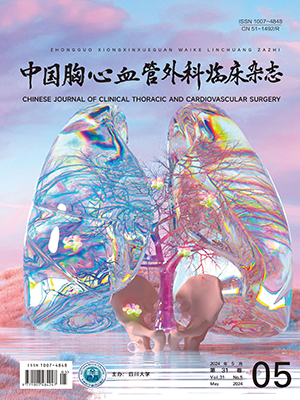| 1. |
Holm NR, Mäkikallio T, Lindsay MM, et al. Percutaneous coronary angioplasty versus coronary artery bypass grafting in the treatment of unprotected left main stenosis: Updated 5-year outcomes from the randomised, non-inferiority NOBLE trial. Lancet, 2020, 395(10219): 191-199.
|
| 2. |
Mohr FW, Morice MC, Kappetein AP, et al. Coronary artery bypass graft surgery versus percutaneous coronary intervention in patients with three-vessel disease and left main coronary disease: 5-year follow-up of the randomised, clinical SYNTAX trial. Lancet, 2013, 381(9867): 629-638.
|
| 3. |
Mehta GS, LaPar DJ, Bhamidipati CM, et al. Previous percutaneous coronary intervention increases morbidity after coronary artery bypass grafting. Surgery, 2012, 152(1): 5-11.
|
| 4. |
Biancari F, Dalén M, Ruggieri VG, et al. Prognostic impact of multiple prior percutaneous coronary interventions in patients undergoing coronary artery bypass grafting. J Am Heart Assoc, 2018, 7(20): e010089.
|
| 5. |
Mannacio V, Di Tommaso L, De Amicis V, et al. Previous percutaneous coronary interventions increase mortality and morbidity after coronary surgery. Ann Thorac Surg, 2012, 93(6): 1956-1962.
|
| 6. |
Bugajski P, Greberski K, Kuzemczak M, et al. Impact of previous percutaneous coronary interventions on the course and clinical outcomes of coronary artery bypass grafting. Kardiol Pol, 2018, 76(6): 953-959.
|
| 7. |
Ueki C, Sakaguchi G, Akimoto T, et al. Influence of previous percutaneous coronary intervention on clinical outcome of coronary artery bypass grafting: A meta-analysis of comparative studies. Interact Cardiovasc Thorac Surg, 2015, 20(4): 531-537.
|
| 8. |
Kolh P, Windecker S. ESC/EACTS myocardial revascularization guidelines 2014. Eur Heart J, 2014, 35(46): 3235-3236.
|
| 9. |
Nicolau JC, Stevens SR, Al-Khalidi HR, et al. Does prior coronary angioplasty affect outcomes of surgical coronary revascularization? Insights from the STICH trial. Int J Cardiol, 2019, 291: 36-41.
|
| 10. |
Miguel GSV, Sousa AG, Silva GS, et al. Does prior percutaneous coronary intervention influence the outcomes of coronary artery bypass surgery? Braz J Cardiovasc Surg, 2020, 35(1): 1-8.
|
| 11. |
Ueki C, Miyata H, Motomura N, et al. Previous percutaneous coronary intervention does not increase adverse events after coronary artery bypass surgery. Ann Thorac Surg, 2017, 104(1): 56-61.
|
| 12. |
Stevens LM, Khairy P, Agnihotri AK. Coronary artery bypass grafting after recent or remote percutaneous coronary intervention in the Commonwealth of Massachusetts. Circ Cardiovasc Interv, 2010, 3(5): 460-467.
|
| 13. |
Sánchez E, Cid-Cumplido M, Moreno-Millán E, et al. Previous percutaneous coronary intervention does not increase in-hospital mortality after surgical revascularization: Analysis of 63 420 cases. Rev Argent Cardiol, 2013, 81: 208-214.
|
| 14. |
Fukui T, Tanaka S, Takanashi S. Previous coronary stents do not increase early and long-term adverse outcomes in patients undergoing off-pump coronary artery bypass grafting: A propensity-matched comparison. J Thorac Cardiovasc Surg, 2014, 148(5): 1843-1849.
|
| 15. |
Mariscalco G, Rosato S, Serraino GF, et al. Prior percutaneous coronary intervention and mortality in patients undergoing surgical myocardial revascularization: Results from the E-CABG (European Multicenter Study on Coronary Artery Bypass Grafting) with a systematic review and meta-analysis. Circ Cardiovasc Interv, 2018, 11(2): e005650.
|
| 16. |
张林, 高长青, 李伯君, 等. 既往经皮冠状动脉介入治疗对冠状动脉旁路手术结局的影响. 浙江大学学报(医学版), 2012, 41(2): 196-199, 209.
|




